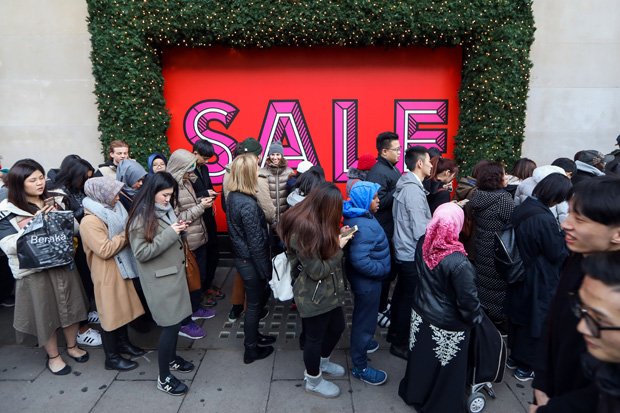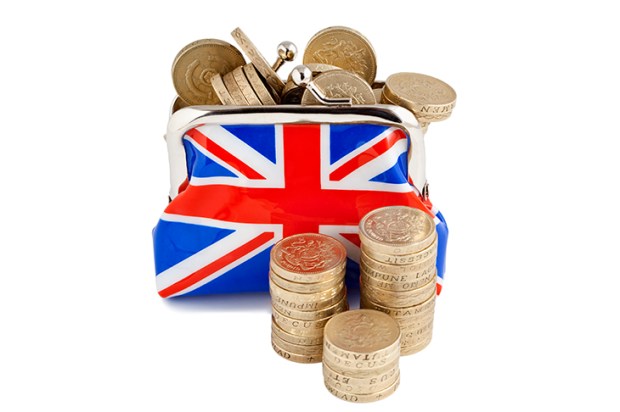At the Westfield shopping centre in east London, the queues started at 2 a.m. on Christmas night. In Wrexham, people started lining up at three, getting ready for a six o’clock start. In Edinburgh, hardy shoppers braved flurries of morning snow to make sure they were first in line for Boxing Day bargains. Whatever else is happening at the close of this year, British shoppers are as indefatigable as ever in their determination to keep spending.
Surely it wasn’t meant to be like this? In the wake of the vote to leave the EU back in June, mainstream economists were unanimous in their view that we would be in a recession by now. Unemployment would have soared, inflation would be out of control, investment would have evaporated, and the pound would have sunk below parity with both the euro and the dollar. The only thing we were meant to be doing in the sales was scavenging for old Mad Max DVDs, seeking tips on how to survive in the post–apocalyptic wasteland that our economy was about to become.
Instead, the script is very different. Most economists have been so determined to convince us that leaving the EU has been a catastrophe, and so busy looking for scraps of evidence of a slowdown, that they have completely ignored the real danger. In reality, there has been no post-referendum bust — no matter how many economists keep looking for one. But there is a genuine threat of a far more traditional British problem: a runaway consumer boom, fuelled by underpriced debt, which ends up in a nasty crash. Should that happen, the economists, and in particular the Bank of England, will be largely to blame.
The evidence that the economy has taken the Brexit vote comfortably in its stride is, by now, surely overwhelming. Employment, although it took a small dip last month, is at record levels. Retail sales are surging, up by another 6 per cent in the most recent set of figures, and the month before grew at the fastest rate in 14 years. Outside the few parts of central London dominated by Russian and Chinese money, house prices are strong. Companies are still investing in the UK — take a look at the decision by McDonald’s to move its global headquarters to London. Even the pound has recovered some of its verve, clawing back almost half its post-Brexit losses against the euro. If that is what an economic ‘catastrophe’ looks like, the Greeks, the Italians or indeed the French would be grateful for one.
There should not be any great mystery about that. In the first half of the year, the economy was already growing at an annual rate of 2 per cent. A fast-growing money supply suggested that it was about to accelerate even more. Then, in the immediate aftermath of the referendum, amid predictions of a sharp slowdown, it received a major stimulus. The Bank of England, expecting calamity, halved interest rates to 0.25 per cent and restarted its programme of quantitative easing, cranking up the printing presses to throw another £70 billion of freshly minted cash at the economy. At the same time, the pound sharply devalued, dropping as low as $1.18 against the dollar — a stimulus in itself — and the government formally abandoned austerity by ditching the target of balancing the budget. That’s the kind of plan which central bankers and the IMF usually recommend for an economy in deep, deep trouble.
But here’s the catch. The British economy wasn’t in trouble. It was doing fine, and in a world with low global tariffs EU membership doesn’t make much difference one way or the other, so there was no real reason to expect it to slow down because we had decided to leave. If a camp fire is burning nicely, and you throw petrol on it, you suddenly get an out of out of control blaze. Likewise, if an economy is growing at a decent clip, and you chuck a massive monetary stimulus at it, what happens? You get a runaway consumer boom.
There are worrying signs that such a boom is exactly what we are starting to see. The growth of consumer debt has doubled over the last three years, with the rate of expansion accelerating after the referendum. The household savings ratio is falling again: another sign that the public is not expecting calamity. The trade deficit has widened to an alarming 6 per cent of GDP, not because exports are not growing, but because we keep importing more and more stuff (most of those ‘80 per cent off’ bargains in the sales have ‘Made in China’ labels). The British consumer isn’t worried about their employer relocating to Lyon or Munich after we leave the EU. Instead, they are doing what they usually do when they feel good about their future — heading down to the mall, emptying their bank accounts and maxing out the credit card to enjoy themselves.
We have seen this movie twice before under Tory governments: the Barber boom of the early 1970s and the Lawson boom of the late 1980s. In both, the economy was overstimulated, creating a bubble which then collapsed in on itself. Now, the same thing appears to be happening all over again. We can’t see it, because virtually the entire economics profession is trapped in the Remain bubble. Economists are guilty of the worst kind of confirmation bias. They are so determined to believe that leaving the EU will be bad that they spend all their time looking for signs of a slowdown, airily dismissing any evidence of a boom as an outlier, or a rogue set of statistics. Indeed, most mainstream forecasts still expect a downturn once we trigger Article 50 next year.
Instead, we are far more likely to see rising consumer spending, rising debt levels, a flood of imports, a gradual build-up of inflation, and, in time, lots more wild lending from the banks as they grow more confident in rising prosperity. This boom may well end up with a crash in 2018 or 2019. If so, it will be one that mainstream economists and the Bank of England will have created themselves, by overestimating the impact of Brexit — although, predictably enough, they won’t see it coming.
Got something to add? Join the discussion and comment below.
Get 10 issues for just $10
Subscribe to The Spectator Australia today for the next 10 magazine issues, plus full online access, for just $10.
You might disagree with half of it, but you’ll enjoy reading all of it. Try your first month for free, then just $2 a week for the remainder of your first year.















Comments
Don't miss out
Join the conversation with other Spectator Australia readers. Subscribe to leave a comment.
SUBSCRIBEAlready a subscriber? Log in